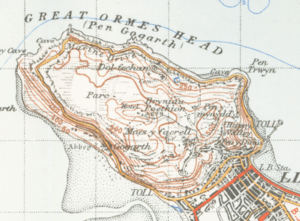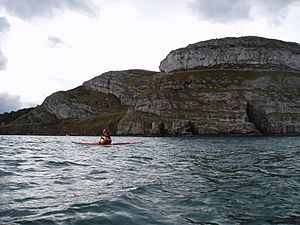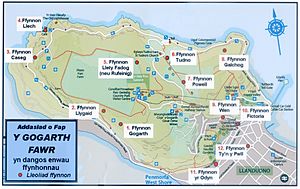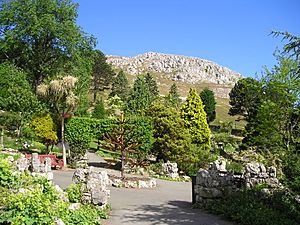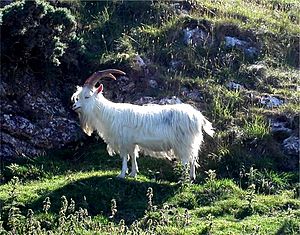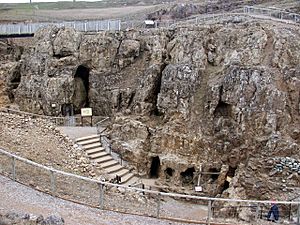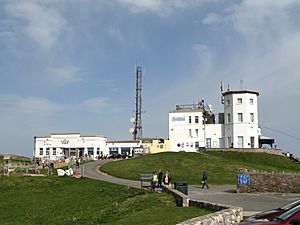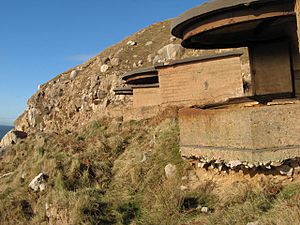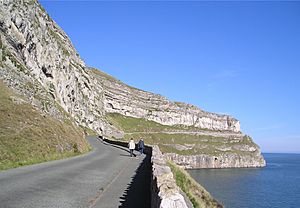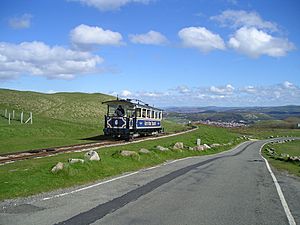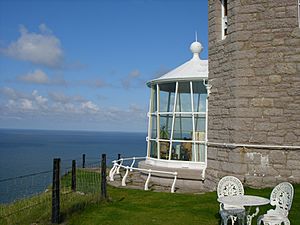Great Orme facts for kids
Quick facts for kids Great Orme |
|
|---|---|
| Pen y Gogarth | |
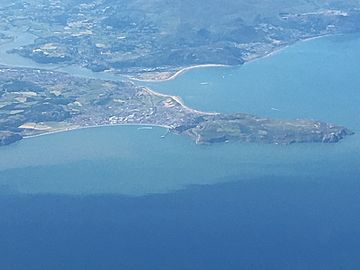
Great Orme and Llandudno
|
|
| Highest point | |
| Elevation | 207 m (679 ft) |
| Prominence | 201 m (659 ft) |
| Parent peak | Mwdwl-eithin |
| Listing | Marilyn |
| Geography | |
| Location | Conwy county borough, Wales |
| OS grid | SH767833 |
| Topo map | OS Landranger 115 |
The Great Orme is a large headland (a piece of land sticking out into the sea) on the north coast of Wales. It's located north-west of the town of Llandudno. Its English name comes from an old Viking word for "sea serpent". There's also a smaller, similar headland called the Little Orme on the other side of Llandudno Bay.
Contents
What's in a Name?
Both the Great and Little Ormes get their names from old Viking words like urm or orm, which mean "sea serpent". Imagine the Great Orme as the head of a giant sleeping creature, with its body being the land between it and the Little Orme. That's one idea for how it got its name! The Vikings visited North Wales a long time ago, even though they didn't settle there permanently.
The name "Orme" wasn't used much until the town of Llandudno became a popular holiday spot in the mid-1800s. Before that, people mostly used Welsh names for the headland and the area around it. The whole peninsula was known as the Creuddyn. The headland itself was called Y Gogarth or Pen y Gogarth.
The name "Orme" probably became popular because many tourists arrived by sea. The headland was the first thing they saw on their journey from Liverpool.
Nature and Wildlife
Parts of the Great Orme are protected as a nature reserve. It's about 2 miles (3.2 km) long and 1 mile (1.6 km) wide. It has special protections like being a Special Area of Conservation and a Heritage Coast. This means it's a very important place for nature. There are many paths for walking to the top. About half of the Great Orme is used for farming, mostly for sheep.
Rocks and Land
The Great Orme is mostly made of limestone and dolomite. These rocks formed about 339 to 326 million years ago! You can see flat areas of limestone pavement on the surface. The Great Orme also has rich amounts of copper ore. It's believed that the ancient copper mine here produced enough copper to make about 2,000 tons of bronze during the Bronze Age.
Important Wells
Natural wells were very important on the Great Orme because they provided water for copper mining, homes, and farms. Here are a few:
- Ffynnon Gogarth: This was the main water source for the old community of Gogarth. It also helped power pumps in the copper mine.
- Ffynnon Rufeining: Meaning "Roman Well," it's thought that Roman copper miners used this water to wash copper ores.
- Ffynnon Gaseg: Meaning "Mare's well," this spring was found when the Marine Drive road was built. It was perfect for horses to drink from during carriage rides.
Amazing Plants
The Great Orme has many special plants. It's the only place in the world where the critically endangered wild cotoneaster (Cotoneaster cambricus) grows naturally. Only six of these plants are known to exist! Many flowers here are like those found in cold, high places, because they developed after the last Ice Age.
In spring and early summer, you can see flowers like bloody cranesbill and thrift clinging to the cliffs. On the grassy areas, you'll find pyramidal orchid and wild thyme. Old mines and quarries also provide homes for plants like spring squill. The white horehound plant, found on the western slopes, was likely used by monks in the 14th century to make herbal medicines.
Wonderful Animals
The Great Orme is home to several rare butterflies and moths, including the silver-studded blue and the grayling. These butterflies have adapted to the Orme by being smaller and appearing earlier in the year.
About 200 Kashmir goats live on the headland. This herd has been here since the mid-1800s. They are descendants of goats given to Queen Victoria by the Shah of Persia in 1837. The Royal Welsh army regiment is allowed to choose a goat from this herd to be their special mascot!
The caves and old mine tunnels are home to large groups of rare horseshoe bats. These small flying mammals use echolocation (like sonar) to find their way in the dark. During the day, they hang upside down in the caves. At night, they fly out to eat beetles and moths.
The cliffs are also home to many seabirds like guillemots, kittiwakes, and razorbills. You can also spot ravens, little owls, and peregrine falcons. Below the cliffs, the rock pools are full of sea creatures like barnacles and hermit crabs.
History of the Great Orme
Ancient Copper Mines
People started mining copper on the Great Orme about 4,000 years ago, during the Bronze Age. They used stones and bone tools to dig out the copper ore. It's thought that about 1,760 tons of copper were mined here during that time. This mine was so productive that by 1600 BC, it was the only copper mine left open in Britain!
The mine was abandoned for a long time, then reopened in the late 1600s. Mining continued until 1881. In 1987, work began to improve the old mine site, and over 5 miles (8 km) of ancient tunnels were discovered! Experts believe that less than half of the prehistoric tunnels have been found so far.
In 1991, the Great Orme Mines opened to the public. You can now explore some of the surface excavations and see mining tools and displays about life in the Bronze Age. You can even visit the 3,500-year-old Great Cavern.
Medieval Times
In the Middle Ages, there were three small villages on the lower slopes of the Great Orme. One of these, Y Gogarth, had a palace belonging to the Bishop of Bangor. This palace was burned down in 1400.
Another village, Cyngreawdr, was home to St Tudno's Church, which was built around the 6th or 7th century. Today, Llandudno's Victorian cemetery is next to this old church. Open-air services are still held there every summer.
Victorian Era Growth
In 1826, the top of the Great Orme became home to one of 11 semaphore stations. These stations used tall masts with moving arms to send messages quickly between Liverpool and Holyhead. Skilled operators could send messages in under a minute!
In 1855, the station switched to electric telegraph, using wires. By the late 1860s, Llandudno's growing tourism meant many visitors came to the summit to enjoy the views. This led to the development of the summit area, which eventually included a hotel and a golf course. During the Second World War, the RAF built a radar station here.
Second World War Role
During the Second World War, the Great Orme was used as a coastal artillery school. Soldiers practiced shooting at targets from the headland. There was also a secret radar experimental station built here in 1942. The remains of some of these old buildings can still be seen today.
Fun for Visitors
The first path around the Great Orme was built in 1858. Later, it was turned into a carriage road called the Marine Drive, which opened in 1878. This 4-mile (6.4 km) one-way road offers amazing views. It has even been used as a stage for the Wales Rally GB car race!
To get to the top of the Great Orme, you can take the Great Orme Tramway, which was built in 1902. Or, you can ride the Llandudno Cable Car, built in 1969. At the summit, you'll find shops, a cafe, a visitor's centre, and play areas.
On clear days, you can see far away places like the Isle of Man and the Lake District from the top!
The Orme also has one of only two artificial ski slopes in North Wales, along with one of the longest toboggan runs in the UK.
On the northernmost point of the Orme is the old Llandudno lighthouse. It was built in 1862 and used until 1985. Now, it's a small bed & breakfast guest house! The original lamp from the lighthouse is on display at the Summit Complex visitor's centre.
Images for kids


